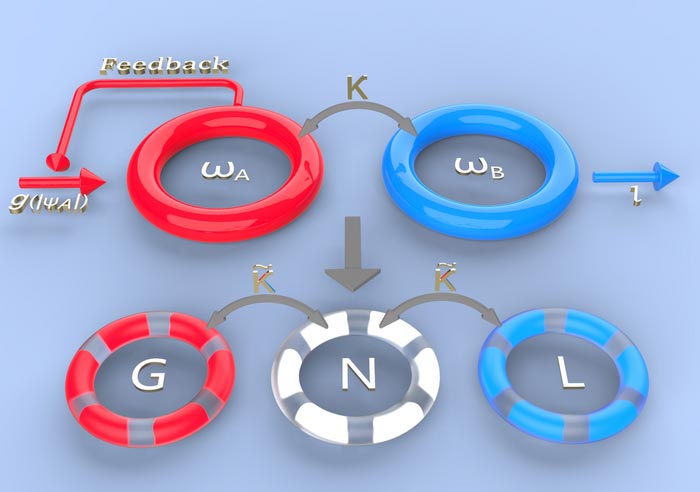Nonlinear exceptional nexus with ultra-enhanced signal-to-noise ratio

The upper panel shows two coupled resonators. The left resonator (red) has nonlinear saturable gain, and the other resonator (blue) has linear loss. Such a nonlinear non-Hermitian system can be mapped into a PT symmetric three-resonator system as shown in the lower panel with linear gain (G), neutral (N) and loss (L) resonators.
Credit: ©Science China Press
This study comes from Prof. Duanduan Wan and Prof. Meng Xiao group at the School of Physics of Wuhan University. This work provides a simple while intuitive example by demonstrating with both theory and circuit experiments an “exceptional nexus” (“EX”), a higher-order exceptional point (HOEP). This HOEP is realized within only two coupled resonators with the aid of nonlinear gain. Moreover, such a HOEP exhibits an ultra-enhanced signal-to-noise ratio.
The recent advances in non-Hermitian physics, such as sensitivity enhancement, skin effects, and mode braiding, are underlain by the exceptional points (EPs). Over the last few years, there has been an ongoing debate about whether EPs can improve the sensor’s performance or not.
Possible arguments include stringent parameter requirements, fundamental resolution limits, and noise amplification near the EPs. Facing these challenges, researchers intend to conclude that EPs, even higher-order EPs (HOEPs), enhance responsivity instead of signal-to-noise ratio. Here, this team from Wuhan University shows that such a nonlinearity enabled HOEP exhibits not only diverging responsivity but also diverging signal-to-noise ratio.
Exploring the nonlinear gain saturation in non-Hermitian systems, this team demonstrates with both theory and circuit experiments an exceptional nexus (EX), a HOEP, within only two coupled resonators (see the first image). Intriguingly, the above-mentioned difficulties encountered for other EPs in sensing can be naturally reconciliated due to the exquisite dimension correlation in this nonlinear system. Moreover, the signal-to-noise ratio is significantly improved in the proximity of HOEP (see the second image).
This result can have significant instant impacts on the fundamental understanding of the exceptional singularities of nonlinear non-Hermitian systems, and may open new avenues for applications such as ultrasensitive measurements.
See the article:
Nonlinearity enabled higher-order exceptional singularities with ultra-enhanced signal-to-noise ratio
https://doi.org/10.1093/nsr/nwac259
Journal: National Science Review
DOI: 10.1093/nsr/nwac259
All latest news from the category: Physics and Astronomy
This area deals with the fundamental laws and building blocks of nature and how they interact, the properties and the behavior of matter, and research into space and time and their structures.
innovations-report provides in-depth reports and articles on subjects such as astrophysics, laser technologies, nuclear, quantum, particle and solid-state physics, nanotechnologies, planetary research and findings (Mars, Venus) and developments related to the Hubble Telescope.
Newest articles

New model of neuronal circuit provides insight on eye movement
Working with week-old zebrafish larva, researchers at Weill Cornell Medicine and colleagues decoded how the connections formed by a network of neurons in the brainstem guide the fishes’ gaze. The…

Innovative protocol maps NMDA receptors in Alzheimer’s-Affected brains
Researchers from the Institute for Neurosciences (IN), a joint center of the Miguel Hernández University of Elche (UMH) and the Spanish National Research Council (CSIC), who are also part of…

New insights into sleep
…uncover key mechanisms related to cognitive function. Discovery suggests broad implications for giving brain a boost. While it’s well known that sleep enhances cognitive performance, the underlying neural mechanisms, particularly…



